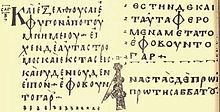Name Regius Size 23.5 cm by 17 cm | Sign L Date 8th century | |
 | ||
Similar Codex Washingtonianus, Codex Petropolitanus Purpureus, Codex Petropolitanus, Codex Zacynthius, Codex Boreelianus | ||
Codex Regius designated by siglum Le or 019 (in the Gregory-Aland numbering), ε 56 (von Soden), is a Greek uncial manuscript of the New Testament, dated paleographically to the 8th century. The manuscript is lacunose. It has marginalia.
Contents
Description
The codex contains 257 thick parchment leaves (23.5 cm by 17 cm), with an almost complete text of the four Gospels. The codex contains five lacunae (Matt 4:22-5:14, 28:17-20, Mark 10:16-30, 15:2-20, John 21:15-25).
The text is written in two columns per page, 25 lines per page, in large, not round uncial letters. It has breathings (Spiritus asper, Spiritus lenis), and accents often added wrongly. It is carelessly written by an ignorant scribe. The letter phi is enormously large, the letter alpha presents the last stage of the uncial script.
The text is divided according to the κεφαλαια (chapters), whose numbers are given at the margin, and their τιτλοι (titles) at the top of the pages. It contains also the tables of the κεφαλαια (tables of contents) before each Gospel. There is also another division according to the Ammonian sections, with references to the Eusebian Canons at the margin. It contains lectionary markings at the margin (for liturgical reading).
It was badly written by the scribe, who was more probably Egyptian than Greek, with a tendency for writing Coptic rather than Greek.
It has two endings to the Gospel of Mark (as in codices Ψ 099 0112 274mg 579 Lectionary 1602), while John 7:53-8:11 is omitted.
In Matthew 1:10 it reads Αμων for Αμως (א, B, C), the reading of the codex agrees with W, f13 and the Byzantine text.
Text
The Greek text of this codex is representative of the Alexandrian text-type in its late stadium. It contains a large number of Byzantine readings in the Gospel of Matthew (1:1–17:26). Aland placed it in Category II, which means it has a number of non-Alexandrian readings. According to Wisse, who examined Luke 1; 10; 20, their text is a "core member" of the Alexandrian text.
It is probably the fourth-best manuscript of the Gospels, inferior only to P75, Codex Vaticanus, and Codex Sinaiticus. It is much closer to Vaticanus than to Sinaiticus.
In some cases it supports Sinaiticus and Vaticanus against almost all of the rest of manuscripts. In Matt 23:38 word ερημος (desert) omitted like in B and ℓ 184. In Matt 19:29 instead εκατονπλασιονα (hundredfold) it has πολλαπλασιονα (manifold) like in codices B and 1010.
In Matthew 19:16 it reads διδασκαλε (teacher) along with manuscripts: א, B, D, f1, 892txt, 1010, 1365, ℓ 5, ita, d, e, ff1, copbo, eth, geo, Origen, Hilary;
In Luke 22:1 it reads ηγγισεν for εγγιζεν along with Codex Bezae.
In Luke 4:17 it has textual variant καὶ ἀνοίξας τὸ βιβλίον (and opened the book) together with the manuscripts A, B, W, Ξ, 33, 892, 1195, 1241, ℓ 547, syrs, h, pal, copsa, bo, against variant καὶ ἀναπτύξας τὸ βιβλίον (and unrolled the book) supported by א, Dc, K, Δ, Θ, Π, Ψ, f1, f13, 28, 565, 700, 1009, 1010 and many other manuscripts.
In Luke 14:5 it reads ὄνος ἢ βοῦς for υἱὸς ἢ βοῦς; the reading of the codex is supported by א, K, L, X, Π, Ψ, f1, f13, 33, 892, 1071, ℓ 547;
It was noted in the 19th century that there is strong resemblance to Codex Vaticanus, to the citations of Origen, and to the margin of the Harkleian Syriac.
History
Probably it was written in Egypt.
The text of the codex was cited by Robert Estienne as η' in his Editio Regia. It was loosely collated by Wettstein. Griesbach set a very high value on the codex. It was edited in 1846 by Tischendorf (Monumenta sacra inedita), but with errors.
The codex is located now at the Bibliothèque nationale de France (Gr. 62), in Paris.
